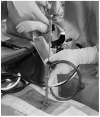Intradiscal Gelified Ethanol Nucleolysis versus Endoscopic Surgery for Lumbar Disc Herniation Radiculopathy
- PMID: 37443558
- PMCID: PMC10341163
- DOI: 10.3390/diagnostics13132164
Intradiscal Gelified Ethanol Nucleolysis versus Endoscopic Surgery for Lumbar Disc Herniation Radiculopathy
Abstract
The purpose of this study was to retrospectively compare efficacy and safety between intradiscal injection of a gelified ethanol product and tubular discectomy in the treatment of intervertebral disk herniation. A bi-central institutional database research identified forty (40) patients suffering from symptomatic contained disc herniation. Nucleolysis Group included 20 patients [mean 50.05 ± 9.27 years-of-age (male/female 14/6-70/30%)] and Surgery Group included 20 patients [mean 48.45 ± 14.53 years-of-age, (male/female 12/8-60/40%)]. Primary outcome was overall 12-month improvement over baseline in leg pain (NVS units). Procedural technical outcomes were recorded, and adverse events were evaluated at all follow-up intervals. CIRSE classification system was used for complications' reporting. Mean pre-operative pain score in Nucleolysis Group was 7.95 ± 0.94 reduced to 1.25 ± 1.11 at month 1 and 0.45 ± 0.75 NVS units at year 1. Mean pre-operative pain score in Surgery Group was 7.65 ± 1.13 reduced to 1.55 ± 1.79 at month 1 and 0.70 ± 1.38 NVS units at year 1. Pain decrease was statistically significant after both procedures (p < 0.001). There was no statistically significant difference between pain reduction in both groups (p = 0.347). The decrease differences of the pain effect upon general activities, sleeping, socializing, walking, and enjoying life in the follow-up period between the two groups were not statistically significant. No complications were noted in both groups. Results from the current study report that intradiscal injection of a gelified ethanol and tubular discectomy were equally effective on terms of efficacy and safety for the treatment of symptomatic lumbar intervertebral disc herniation regarding the 12-month mean leg pain improvement. Both achieved similar rapid significant clinical improvement persisting throughout follow-up period.
Keywords: alcohol; herniation; injection; intervertebral disc; pain; tubular discectomy.
Conflict of interest statement
The authors declare no conflict of interest.
Figures





Similar articles
-
Intradiscal oxygen-ozone chemonucleolysis versus microdiscectomy for lumbar disc herniation radiculopathy: a non-inferiority randomized control trial.Spine J. 2022 Jun;22(6):895-909. doi: 10.1016/j.spinee.2021.11.017. Epub 2021 Dec 9. Spine J. 2022. PMID: 34896609 Clinical Trial.
-
Residual leg numbness after endoscopic discectomy treatment of lumbar disc herniation.BMC Musculoskelet Disord. 2020 Apr 27;21(1):273. doi: 10.1186/s12891-020-03302-5. BMC Musculoskelet Disord. 2020. PMID: 32340609 Free PMC article.
-
Percutaneous transforaminal endoscopic discectomy compared with microendoscopic discectomy for lumbar disc herniation: 1-year results of an ongoing randomized controlled trial.J Neurosurg Spine. 2018 Mar;28(3):300-310. doi: 10.3171/2017.7.SPINE161434. Epub 2018 Jan 5. J Neurosurg Spine. 2018. PMID: 29303469 Clinical Trial.
-
Comparative outcomes of epidural steroids versus placebo after lumbar discectomy in lumbar disc herniation: a systematic review and meta-analysis of randomized controlled trials.Eur J Orthop Surg Traumatol. 2018 Dec;28(8):1589-1599. doi: 10.1007/s00590-018-2229-4. Epub 2018 May 29. Eur J Orthop Surg Traumatol. 2018. PMID: 29845327
-
Ozone Disc Nucleolysis for Cervical Intervertebral Disc Herniation: A Systematic Review and Meta-Analysis.Cureus. 2024 May 8;16(5):e59855. doi: 10.7759/cureus.59855. eCollection 2024 May. Cureus. 2024. PMID: 38854278 Free PMC article. Review.
Cited by
-
Long-term clinical efficacy of radioplaque gelified ethanol for lumbar disc herniation: a multicenter study.Neuroradiology. 2025 May;67(5):1341-1347. doi: 10.1007/s00234-025-03603-3. Epub 2025 Apr 8. Neuroradiology. 2025. PMID: 40198365
References
LinkOut - more resources
Full Text Sources

